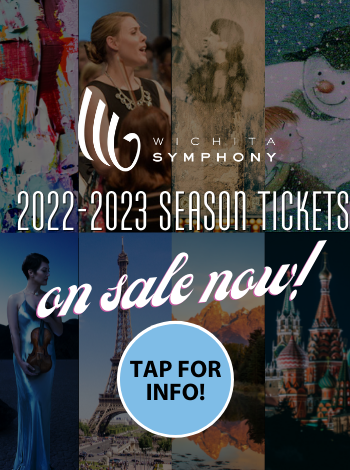AARON COPLAND
Born November 14, 1900, in Brooklyn, NY
Died December 2, 1990, in Peekskill, NY
Rodeo – Four Dance Episodes (20’)
- Buckaroo Holiday
- Corral Nocturne
- Saturday Night Waltz
- Hoe-Down
Last performed by the Wichita Symphony on November 19 and 20, 2005. Andrew Sewell conducted.
The audience settling into their seats on the autumnal evening of October 16, 1942, at the old Metropolitan Opera House on 39th Street and Broadway in New York City, would be excused for wanting a performance of distracting entertainment. For less than a year, the nation had been at war, and all reports indicated this would be a long and costly struggle. The Ballet Russe de Monte Carlo, successors to Diaghilev’s Ballets Russes, were ready to accommodate.
The Ballet, already hunkering down in New York City to wait out the war and led by Sergei Ivanovitch Denham, was presenting a new ballet by the young and largely unknown American dancer Agnes de Mille (1905 – 1993). With a pedigree of her own as the daughter and niece of William and Cecil de Mille, two tycoons of the Hollywood motion picture industry, Agnes attracted attention as an avant-garde dancer who combined elements of traditional ballet with popular and modern dance.
For her new work, de Mille envisioned a ranch in southwest Texas. Upon being asked who she wanted for a composer, she immediately said, “Aaron Copland,” with whom she had a passing acquaintance since the 1930s. By 1942, Copland was already considered the leading American composer sought after by young aspiring composers like Leonard Bernstein at the summer retreat of Tanglewood. After meeting with de Mille, Copland, with another western-themed ballet, Billy the Kid, already to his credit, accepted the $1,000 commission.
De Mille conceived the ballet in two parts with the working title of “The Courting at Burnt Ranch.” In Part One, people wander around the corrals during the intermission of a rodeo. Girls flirt with the cowboys, and the rodeo resumes. At twilight, a cowgirl sits outside and muses upon the spaciousness of the land and sky of the prairie. In Part 2, a dance takes place at night. A waltz commences and eventually moves outside, where a vigorous hoe-down breaks out.
De Mille commented on the nature of the ballet: “The theme of the ballet is quite basic. It deals with the problem that has confronted all American women, from earliest pioneer times…how to get a suitable man.”1 That might raise eyebrows today, and some feminists eventually denounced the ballet; but in wartime America with young men leaving for the armed services, it was a relevant subject.
Sol Hurok (1888 – 1974), the impresario charged with promoting the concert, thought the original title was too long and urged something shorter. Hence the title, Rodeo, was applied with the pronunciation of ro-DAY-oh to lend a bit of marketing clout.
As the third work on the program, the ballet, complete with choreography evoking how cowboys walk and ride broncos, was a smash hit. De Mille danced the part of the cowgirl. There were twenty-two curtain calls with Copland joining the dancers onstage. Irving Kolodin, reviewing the performance for the New York Sun, wrote, “The Ballet Russe de Monte Carlo awoke to find itself with a genuine American ballet today, and is it surprised!” Writing later for the Chicago Daily Tribune, Claudia Cassidy called Rodeo “a shining little masterpiece.” Richard Rodgers and Oscar Hammerstein, who were in the audience on opening night, immediately invited de Mille to join them on a new collaborative venture titled Oklahoma. Rodeo went on to enjoy seventy-nine performances during the 1942 – 1932 season.
A year later, Copland expanded the orchestration from a pit orchestra to that of a full orchestra, giving the pianist a significant part. Preserving all but five minutes of the ballet, he retitled the music Rodeo: Four Dance Episodes. Arthur Fiedler and the Boston Pops premiered the new suite on May 28, 1943. This version became more popular than the ballet itself and is the version we hear at the Wichita Symphony this weekend.
Copland’s music during the 1930s and 1940s became synonymous with what we call “the American sound.” Works like Billy the Kid, Lincoln Portrait, Rodeo, and Appalachian Spring, each imbued with popular elements, influenced many composers, particularly those seeking to create a sense of Americana in film scores. With its melodic contours and rhythmic vitality, Copland’s music evokes the American landscape. During the mid-20th century, his music captures a sense of the Great Plains; later, as his style becomes more angular, the shapes of the urban skyline.
The Americanism of Rodeo contains direct and assimilated references to American folk music. We hear quotes like “I Ride an Old Paint in the Saturday Night Waltz movement.” In Hoe-Down, fiddle tunes like “Bonaparte’s Retreat,” “Tip, Toe, Pretty Betty Martin,” and others appear. The titles may be long-forgotten by contemporary audiences, but the sense of place and time remains.
Hoe-Down exists in a life of its own. The rock group Emerson, Lake, and Palmer created a notable arrangement of Hoe-Down on their Trilogy Album (1972). Bela Fleck and the Flecktones recorded their version on the 2000 album Outbound. Many will remember the use of Hoe-Down in Wendy’s 1990s commercial for fast-food hamburgers, “Where’s the Beef.”
The composer and music critic Arthur Berger (1912 – 2003) described Copland’s Hoe-Down as “virtually photographic.” That description is apt for the entire work. In that spirit, we welcome multimedia artist and photographer Nicholas Bardonnay of Westwater Arts to this weekend’s concerts. Bardonnay will choreograph his photography of an American rodeo on three large screens above the orchestra, taking us inside the action with shifting panoramic images.
Notes by Don Reinhold©2022
1 Quoted in Howard Pollack, Aaron Copland: The Life and Work of an Uncommon Man, (NY: Henry Holt and Co., Inc., 1999), p. 365.
